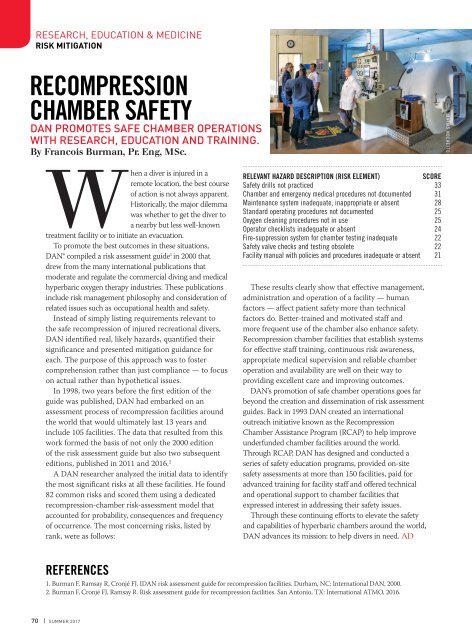AD 2017 Q3
Alert Diver is the dive industry’s leading publication. Featuring DAN’s core content of dive safety, research, education and medical information, each issue is a must-read reference, archived and shared by passionate scuba enthusiasts. In addition, Alert Diver showcases fascinating dive destinations and marine environmental topics through images from the world’s greatest underwater photographers and stories from the most experienced and eloquent dive journalists in the business.
Alert Diver is the dive industry’s leading publication. Featuring DAN’s core content of dive safety, research, education and medical information, each issue is a must-read reference, archived and shared by passionate scuba enthusiasts. In addition, Alert Diver showcases fascinating dive destinations and marine environmental topics through images from the world’s greatest underwater photographers and stories from the most experienced and eloquent dive journalists in the business.
Create successful ePaper yourself
Turn your PDF publications into a flip-book with our unique Google optimized e-Paper software.
RESEARCH, EDUCATION & MEDICINE<br />
RISK MITIGATION<br />
RECOMPRESSION<br />
CHAMBER SAFETY<br />
DAN PROMOTES SAFE CHAMBER OPERATIONS<br />
WITH RESEARCH, EDUCATION AND TRAINING.<br />
By Francois Burman, Pr. Eng, MSc.<br />
MATIAS NOCHETTO<br />
When a diver is injured in a<br />
remote location, the best course<br />
of action is not always apparent.<br />
Historically, the major dilemma<br />
was whether to get the diver to<br />
a nearby but less well-known<br />
treatment facility or to initiate an evacuation.<br />
To promote the best outcomes in these situations,<br />
DAN® compiled a risk assessment guide 1 in 2000 that<br />
drew from the many international publications that<br />
moderate and regulate the commercial diving and medical<br />
hyperbaric oxygen therapy industries. These publications<br />
include risk management philosophy and consideration of<br />
related issues such as occupational health and safety.<br />
Instead of simply listing requirements relevant to<br />
the safe recompression of injured recreational divers,<br />
DAN identified real, likely hazards, quantified their<br />
significance and presented mitigation guidance for<br />
each. The purpose of this approach was to foster<br />
comprehension rather than just compliance — to focus<br />
on actual rather than hypothetical issues.<br />
In 1998, two years before the first edition of the<br />
guide was published, DAN had embarked on an<br />
assessment process of recompression facilities around<br />
the world that would ultimately last 13 years and<br />
include 105 facilities. The data that resulted from this<br />
work formed the basis of not only the 2000 edition<br />
of the risk assessment guide but also two subsequent<br />
editions, published in 2011 and 2016. 2<br />
A DAN researcher analyzed the initial data to identify<br />
the most significant risks at all these facilities. He found<br />
82 common risks and scored them using a dedicated<br />
recompression-chamber risk-assessment model that<br />
accounted for probability, consequences and frequency<br />
of occurrence. The most concerning risks, listed by<br />
rank, were as follows:<br />
RELEVANT HAZARD DESCRIPTION (RISK ELEMENT)<br />
SCORE<br />
Safety drills not practiced 33<br />
Chamber and emergency medical procedures not documented 31<br />
Maintenance system inadequate, inappropriate or absent 28<br />
Standard operating procedures not documented 25<br />
Oxygen cleaning procedures not in use 25<br />
Operator checklists inadequate or absent 24<br />
Fire-suppression system for chamber testing inadequate 22<br />
Safety valve checks and testing obsolete 22<br />
Facility manual with policies and procedures inadequate or absent 21<br />
These results clearly show that effective management,<br />
administration and operation of a facility — human<br />
factors — affect patient safety more than technical<br />
factors do. Better-trained and motivated staff and<br />
more frequent use of the chamber also enhance safety.<br />
Recompression chamber facilities that establish systems<br />
for effective staff training, continuous risk awareness,<br />
appropriate medical supervision and reliable chamber<br />
operation and availability are well on their way to<br />
providing excellent care and improving outcomes.<br />
DAN’s promotion of safe chamber operations goes far<br />
beyond the creation and dissemination of risk assessment<br />
guides. Back in 1993 DAN created an international<br />
outreach initiative known as the Recompression<br />
Chamber Assistance Program (RCAP) to help improve<br />
underfunded chamber facilities around the world.<br />
Through RCAP, DAN has designed and conducted a<br />
series of safety education programs, provided on-site<br />
safety assessments at more than 150 facilities, paid for<br />
advanced training for facility staff and offered technical<br />
and operational support to chamber facilities that<br />
expressed interest in addressing their safety issues.<br />
Through these continuing efforts to elevate the safety<br />
and capabilities of hyperbaric chambers around the world,<br />
DAN advances its mission: to help divers in need. <strong>AD</strong><br />
REFERENCES<br />
1. Burman F, Ramsay R, Cronjé FJ. IDAN risk assessment guide for recompression facilities. Durham, NC: International DAN, 2000.<br />
2. Burman F, Cronjé FJ, Ramsay R. Risk assessment guide for recompression facilities. San Antonio, TX: International ATMO, 2016.<br />
70 | SUMMER <strong>2017</strong>









